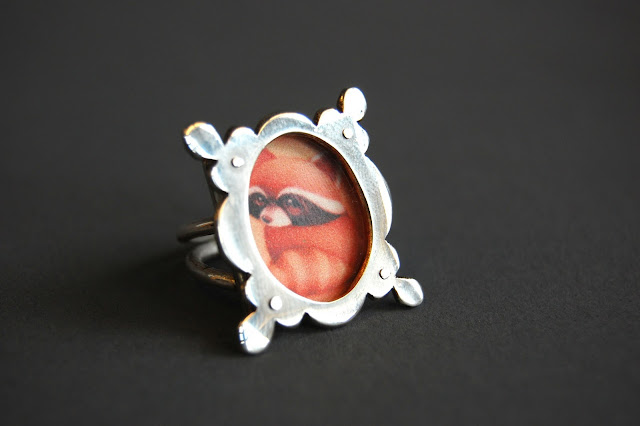-We typically use copper, brass, nickel and sterling silver.
-Metal sheet and wire thickness is measured in gauges. The lower the number, the thicker the metal. 18 gauge is a pretty standard sheet gauge for jewelry.
-With your jewelers saw you can cut any shapes you want too out of sheet metal.
-If you want to cut a shape from the inside of your piece of metal, it's called 'piercing' and you do it by drilling or punching a small hole, then feeding your saw blade through the hole.
-After cutting your shapes, you file all the edges using a variety of files. Pick the right file for your line. Some shapes will use many different files.
- For every shape we cut and file, we also need to deal with the surface of the shape as well.
-Surface treatments include texturing, sanding, patina, and polishing.
-Texturing and patina were discussed in part 4.
If you are new to this blog, you may want to go back to the first and second posts in this series which has the shopping list and more info on all of the above.
More Surface Treatments
Perhaps a funky textured and patinated surface is not your thing, then what? Well, creating a smooth, pristine surface is really pretty easy to do at home and it can be done on the cheap.
We jewelers use wet/dry sandpaper to clean up our surfaces and to get out scratches. You can get wet/dry sandpaper from a hardware store. It's dark grey, it's not the yellow/brownish wood sandpaper. Wet/dry typically comes in 120 grit to 600 grit. The lower the number, the rougher the paper. I typically buy 4 grits: 220, 320,400 and 600. You usually don't need anything rougher than 220.
To clean up your shape and make it really smooth start with 220 and sand back and forth in one direction. Use some muscle to really get out the deep scratches. Try to keep the grain linear in one direction. You will now have a texture from the 220. Take your 320, do the same thing to remove the 220 texture. Use the 400 to remove the 320 texture, and then the 600 to remove the 400 texture. At this point the piece should be pretty smooth and the texture left over from the 600 is very fine.
| Student work: Copper sanded to 600. Liver of Sulfur Patina |
 |
| Student work: Nickel silver sanded to 600. |
Important!! Wet dry sandpaper is called wet/dry because you can work with it wet. The benefits to working wet is that is doesn't kick up as much dust as it will dry. Much better on your lungs if you plan on doing a lot of sanding. Also, the paper is slightly more malleable when it's wet, so you can more easily fold it into little pointy shapes to get into smaller areas. To work with it wet, just have a little bowl of water on your bench you can dip your paper into every now and again.
If you want an even more polished surface you can order a finer grit sandpaper from Rio (page 378). Or, you can buy a polishing machine...
This is not on my initial list of jewelry making essentials, but polishing machines are a relatively inexpensive way to get very professional looking results at home. My high school students tend to love shiny and they all "ooh" and "ah" when I demo how to use it. The important thing about high polishing is that you must go through all the sandpaper stages (220-600) before polishing. If you don't it will look pretty bad, and the imperfections on your surface will stand out even more.
NOTE: NEVER PUT A CHAIN ON A POLISHING MACHINE!
Seriously, you can really hurt your self, as in, like, loosing a finger!
The polishing machine has 2 spindles, one on the left, one on the right. You can attach a variety of brushes and wheels to the spindles depending on what you are wanting to do. For high polishing we use a 2 fabric wheels. Each wheel uses a different polishing compound that we apply to the wheel while its rotating.
There are many different compounds and if you get a machine you should do some research on them, or you can buy the compounds called "Tripoli" and "Rouge". Tripoli goes on the left wheel and it is the first one to use. It is a rougher compound and it is taking out any residual marks from the 600 sandpaper. After using the tripoli, move onto the other wheel and use the rouge compound. The rouge is what gives it a super shiny, mirror like surface.
NEVER MIX COMPOUNDS ON THE SAME WHEEL!
If you want to buy a polishing machine, send me a message and I can give you more info on how to use them. It's pretty darn easy, and you get immediate results.
 |
| Student work: Sterling silver sanded to 600 and then high polished on the machine. |
 |
| Student work: Nickel silver sanded to 600 and then high polished. |
When you begin setting up your home studio it's a good idea to experiment combining all the surface techniques. For example, high polish a textured surface. It's kinda a jewelry no no, but heck, that's what may make it pretty cool.
At this point we have covered the main tools, techniques and purchases for starting your home studio. Next week I will go over some other cool tools that you can add to your studio bit by bit that will open up your jewelry making possibilities even more...
Until then, let me know if you have any questions. Ta ta...
| Teacher work: Silver, textured and sanded with a Liver of Sulfur patina. :) |


